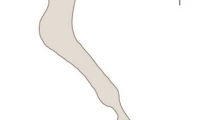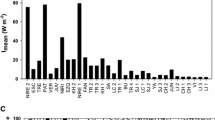Abstract
In Lake Constance, after several decades of cutrophication, a decrease in phosphorus loading over the last decade has lead to a partial recovery from eutrophication. Here we analyse the shift in the taxonomic composition of phytoplankton during the first decade of oligotrophication in Lake Constance. During the 1980s, spring total P concentrations decreased from ca. 130 to less than 50 μ·l−1. This decrease was reflected by an approximately proportional decrease in summer phytoplankton biomass while spring phytoplankton biomass seemed unresponsive. Major taxonomic changes occured during both growth seasons. In spring, the proportion of diatoms, green algae and Chrysophyta increased while the proportion of Cryptophyta decreased. The summer trend was very different: the relative importance of diatoms decreased and Cryptophyta and Chrysophyta increased, while Chlorophyta reached their peak around 1985. These trends are also analysed at the genus level. Comparison with taxonomic trends during the eutrophication period shows the expected reversals in most cases. Comparison with other lakes shows general similarities, with the notable exception that Planktothrix rubescens has never been important in Lake Constance. The increase of diatoms during spring is attributed to their improved competitive performance with increasing Si:P ratios. Their decrease during summer is explained by the increasing silicate removal from the epilimnion by increasing spring populations.
Similar content being viewed by others
References
Davis CC (1964) Evidence for the eutrophication of Lake Erie from phytoplankton records. limnol Oceanogr 9:275–283
Dillon PJ, Rigler FR (1974) The phosphorus-chlorophyll relationship in lakes. Limnol Oceanogr 19:767–773
Droop MR (1983) 25 years of algal growth kinetics. Bot Mar 26:99–112
Gaedke U, Schweizer A (1993) The first decade of oligotrophication in Lake Constance: I. The response of phytoplankton biomass and cell sizes. Oecologia 93:268–275
Geller W (1980) Stabile Zeitmuster in der Planktonsukzession des Bodensees. Verh Ges Ökol 8:372–382
Harris GP (1986) Phytoplankton ecology. Chapman and Hall, London
Kümmerlin R (1991) Long term development of phytoplankton in Lake Constance. Verh Int Ver,Limnol 24:826–830
Kümmerlin R, Bürgi HR (1989) Die langjährige Entwicklung des Phytoplanktons im Bodensee (1961–1986). IGKB Bericht 39
Lampert W, Schober U (1978) Das Regelmäßige Auftreten von Frühjahrs-Algenmaximum und “Klarwasserstadium” als Folge von klimatischen Bedingungen und Wechselbeziehungen zwischen Phyto- und Zooplankton. Arch Hydrobiol 82:364–386
Reynolds CS (1984) The ecology of freshwater phytoplankton. Cambridge University Press
Reynolds CS (1987) The response of phytoplankton to changing lake environments. Schweiz Z Hydrol 49:220–236
Sakamoto M (1967) Primary production by phytoplankton in some Japanese lakes and dependence on lake depth. Arch Hydrobiol 62:1–28
Sas H (1989) Lake restoration by reduction of nutrient loading. Academia Verlag Richarz, St. Augustin FRG
Sommer U (1983) Nutrient competition between phytoplankton in multispecies chemostat cultures. Arch Hydrobiol 96:399–416
Sommer U (1986) The periodicity of phytoplankton in Lake Constance (Bodensee) in comparison to ther deep lakes of central Europe. Hydrobiologia 138:1–7
Sommer U (1987) Factors controlling the seasonal variation in phytoplankton species composition—a case study for a nutrient rich, deep lake. Prog Phycol Res 5:123–178
Sommer U (1988a) Does nutrient competition among phytoplankton occur in situ? Verh Int Ver Limnol 23:707/712
Sommer U (1988b) Growth and survival strategies of planktonic diatoms. In: Sandgren CD (ed) Growth and reproductive strategies of freshwater phytoplankton. Cambridge University Press, pp 227–260
Sommer U (1989a) The role of competition for resources in phytoplankton species succession. In Sommer U (ed): Plankton ecology-succession in plankton communities. Springer, Berlin, pp 57–106
Sommer U (1989b) Phytoplankton nutrient competition — from laboratory to lake. In: Grace JB, Tilman D (eds) Perspectives on plant competition. Academic Press, Orlando Florida, pp 193–213
Sommer U, Gliwicz ZM, Lampert W, Duncan A (1986) The PEG-model of seasonal succesion of planktonic events in fresh waters. Arch Hydrobiol 106:433–471
Stabel HH (1991) Irregular biomass response in recovering prealpine lakes. Verh Int Ver Limnol 24:810–815
Strickland JD, Parsons TR (1968) A practical handbook of seawater analysis. Bull Fish Res Bd Canada 169:1–311
Tilman D, Kilham SS, Kilham P (1982) Phytoplankton community ecology: the role of limiting nutrients. Annu Rev Ecol Syst 13:349–372
Tilzer MM (1983) The importance of fractional light absorption for phytoplankton productivity in lake Constance. Limnol Oceanogr 28:833–846
Tilzer MM (1984) The quantum yield as a fundamental parameter controlling vertical photosynthesis profiles of phytoplankton in Lake Constane. Arch Hydrobiol Suppl 69:169–198
Tilzer MM, Gaedke U, Schweizer A, Beese B, Weisse T (1991) Interannual variability of phytoplankton productivity and related parameters in Lake Constance: No response to decreased phosphorus loading. J Plankton Res 13:755–777
Utermöhl H (1958) Zur Vervollkommnung der quantitativen Phytoplankton-Methodik. Mitt Int Ver Limnol 9:1–38
Vollenweider R, Kerekes J (1982) Eutrophication of waters, monitoring, assessment and control. OECD Paris, 1–154
Author information
Authors and Affiliations
Rights and permissions
About this article
Cite this article
Sommer, U., Gaedke, U. & Schweizer, A. The first decade of oligotrophication of Lake Constance. Oecologia 93, 276–284 (1993). https://doi.org/10.1007/BF00317682
Received:
Accepted:
Issue Date:
DOI: https://doi.org/10.1007/BF00317682




